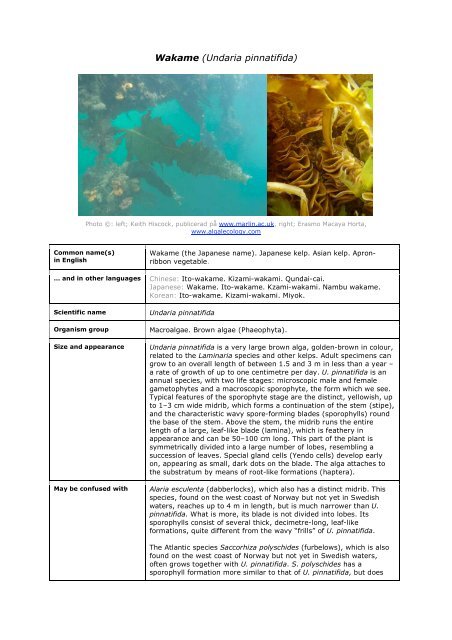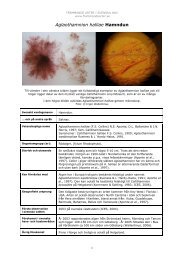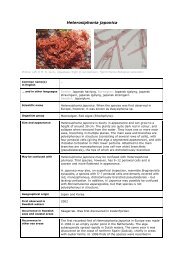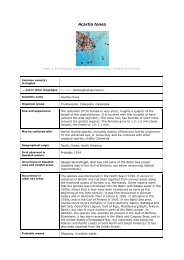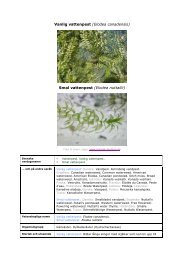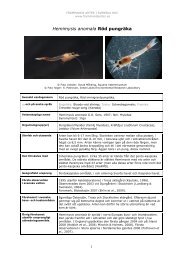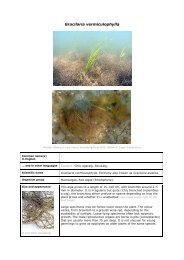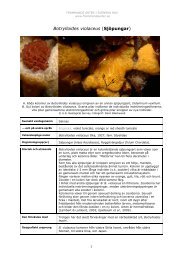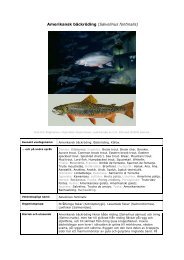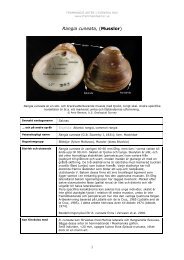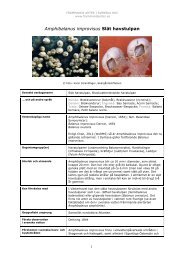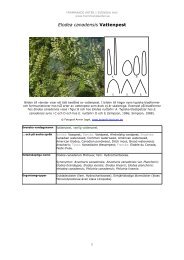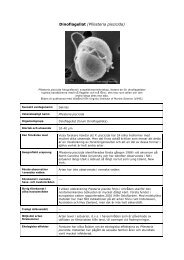Undaria pinnatifida
Undaria pinnatifida
Undaria pinnatifida
You also want an ePaper? Increase the reach of your titles
YUMPU automatically turns print PDFs into web optimized ePapers that Google loves.
Wakame (<strong>Undaria</strong> <strong>pinnatifida</strong>)Photo ©: left; Keith Hiscock, publicerad på www.marlin.ac.uk, right; Erasmo Macaya Horta,www.algalecology.comCommon name(s)in English… and in other languagesScientific nameOrganism groupSize and appearanceMay be confused withWakame (the Japanese name). Japanese kelp. Asian kelp. Apronribbonvegetable.Chinese: Ito-wakame. Kizami-wakami. Qundai-cai.Japanese: Wakame. Ito-wakame. Kzami-wakami. Nambu wakame.Korean: Ito-wakame. Kizami-wakami. Miyok.<strong>Undaria</strong> <strong>pinnatifida</strong>Macroalgae. Brown algae (Phaeophyta).<strong>Undaria</strong> <strong>pinnatifida</strong> is a very large brown alga, golden-brown in colour,related to the Laminaria species and other kelps. Adult specimens cangrow to an overall length of between 1.5 and 3 m in less than a year –a rate of growth of up to one centimetre per day. U. <strong>pinnatifida</strong> is anannual species, with two life stages: microscopic male and femalegametophytes and a macroscopic sporophyte, the form which we see.Typical features of the sporophyte stage are the distinct, yellowish, upto 1–3 cm wide midrib, which forms a continuation of the stem (stipe),and the characteristic wavy spore-forming blades (sporophylls) roundthe base of the stem. Above the stem, the midrib runs the entirelength of a large, leaf-like blade (lamina), which is feathery inappearance and can be 50–100 cm long. This part of the plant issymmetrically divided into a large number of lobes, resembling asuccession of leaves. Special gland cells (Yendo cells) develop earlyon, appearing as small, dark dots on the blade. The alga attaches tothe substratum by means of root-like formations (haptera).Alaria esculenta (dabberlocks), which also has a distinct midrib. Thisspecies, found on the west coast of Norway but not yet in Swedishwaters, reaches up to 4 m in length, but is much narrower than U.<strong>pinnatifida</strong>. What is more, its blade is not divided into lobes. Itssporophylls consist of several thick, decimetre-long, leaf-likeformations, quite different from the wavy “frills” of U. <strong>pinnatifida</strong>.The Atlantic species Saccorhiza polyschides (furbelows), which is alsofound on the west coast of Norway but not yet in Swedish waters,often grows together with U. <strong>pinnatifida</strong>. S. polyschides has asporophyll formation more similar to that of U. <strong>pinnatifida</strong>, but does
not have the same type of long, root-like haptera attaching it to thesubstratum. Instead it has a warty formation, reminiscent of a suctioncup. Furthermore, it lacks the midrib typical of U. <strong>pinnatifida</strong>.Very young specimens of U. <strong>pinnatifida</strong>, at the stage before the typicalmidrib develops, can more easily be confused with other kelps.However, this species very soon develops the distinctive dark Yendocells on its blade.Geographical origin Sea of Japan. The species is native to the north-western Pacific coast –Japan, Korea, south-eastern Russia and eastern parts of China.First observed inSwedish watersOccurrence in Swedishseas and coastal areasOccurrence inother sea areasHas not yet been observed in Swedish waters.Has not yet been observed in Swedish waters.<strong>Undaria</strong> <strong>pinnatifida</strong> was introduced accidentally to the Mediterraneancoast of France in 1971, probably with oysters imported from Japan.Attempts were then made to cultivate this alga, first in FrenchMediterranean waters, and subsequently on the coast of Brittany andfurther south along the Atlantic coast of France. In 1987, in one of theareas where the species was farmed, naturally recruited plants werefound outside the cultivation sites. The species was recorded in 1988in French Atlantic waters close to the border with Spain, and in 1990 itwas reported from northern Spain (Ria de Arosa), where it wasprobably associated with oyster farming. It has not yet been reportedfrom the Mediterranean coast of Spain. Since 1992 the species hasbeen found around the shores of Italy (including in the canals ofVenice and in the Mar Piccolo in southern Italy). Its occurrence inItalian waters is believed to be attributable either to shellfish farms orto shipping. The species was first reported in Britain in 1994,presumably brought there by ships from France. Since 1999 it has alsobeen present in Belgian and Dutch waters, so far probably itsnorthernmost sites on the mainland coast of Europe.U. <strong>pinnatifida</strong> occurs widely around the world and can now be found,for example, in the United States (California), Mexico, Argentina,Australia and New Zealand.Probable meansof introductionHabitat(s) in whichspecies occursAquaculture (imported shellfish) and shipping (in ballast water and asa fouling organism).<strong>Undaria</strong> <strong>pinnatifida</strong> is a tolerant and opportunistic alga. It grows onnatural hard substrata of every kind – stones, rocks and reefs, as wellas mobile cobble substrates. It can also establish itself on softsediments, if there are hard surfaces such as shells to attach to. It canrapidly colonize new and disturbed hard substrates, as well as manmadeand mobile surfaces such as ropes, pontoons, buoys and ships’hulls. In the early stages of its life cycle, U. <strong>pinnatifida</strong> can also growepiphytically on other algae and sea-grasses.As an adult, the species grows in dense stands (“forests”), forminglarge canopies. Up to 200–250 plants have been observed per squaremetre, with a biomass of over 10 kg (wet weight).U. <strong>pinnatifida</strong> can grow at varying depths, from shallow intertidal andsubtidal areas (most commonly found in waters 1–3 m deep) to depthsof around 15–18 m in clear water. It does not thrive in areas with highexposure to waves, developing best at sheltered sites. It can grow intemperate areas with cold water, growing best of all at watertemperatures below 12°C, and does less well in water warmer than a
little over 23°C. The species is not particularly demanding as regardslight availability, being able to grow in everything from full sunlight tovery low levels of light. It does not thrive, though, in areas affected byinputs of fresh water. Provided that the salinity is above roughly 27psu, the species can establish itself virtually anywhere, from cold tomoderately warm waters.Ecological effectsThe dense growth pattern of this alga and the large, shading canopywhich it forms modify the habitats of the species that end up below it.Light availability and water movements are reduced. In addition, thespecies may attach itself to shellfish on the seabed.Since U. <strong>pinnatifida</strong> is an annual species, in European waters it canonly compete with other large annual macroalgae, such as Saccorhizapolyschides. Experiments have shown that entirely bare surfaces areprimarily colonized by native brown algae, rather than by U.<strong>pinnatifida</strong>. What probably favours this species is above all itsopportunistic character, i.e. its ability to grow quickly, establish itselfon disturbed and artificial substrata, and tolerate a wide range ofenvironmental conditions (in terms of light, exposure, temperatureand salinity). As with other large algae that form dense stands, forestsof <strong>Undaria</strong> provide shelter for various benthic animal species. The algais also grazed by certain animals.Other effectsAdditional informationThe large, dense canopies, and the fact that the species attaches toshells, can make it difficult for fishermen to spot shellfish on theseabed. U. <strong>pinnatifida</strong> fouls ropes and lines, buoys, pontoons, cagesused in aquaculture, jetties and other harbour structures, and ships’hulls. There are also reports of the species blocking water intakes.Drifting specimens may be washed up on beaches, formingunpleasant, foul-smelling banks of rotting plant material.In its microscopic gametophyte stage, the species can survive on boathulls, for example, even when the boat is moved by trailer from onearea to another, without contact with water. The gametophyte is verytolerant and can survive several months of darkness, desiccation andvarying temperatures.<strong>Undaria</strong> <strong>pinnatifida</strong> has traditionally been cultivated, above all, inJapan, and since the 1940s also in China. As a cultured species it is ofgreat economic significance in Asia. Wakame, which is rich in fibre, lowin fat and rich in B vitamins and minerals, is used as an ingredient in avariety of dishes, for example as a characteristic seasoning in misosoup. As well as in soups, it is served roasted, as a salad vegetable,with rice and in pickles. The species is also used as a natural remedy.FIND OUT MORE• 120 kB: AquaAliens: <strong>Undaria</strong> <strong>pinnatifida</strong>http://www.aqualiens.tmbl.gu.se/<strong>Undaria</strong>_<strong>pinnatifida</strong>.pdf• 548 kB: AquaAliens: Additions and correctionshttp://www.aqualiens.tmbl.gu.se/<strong>Undaria</strong>_Correction_Addition.pdf• 2,5 MB: ICES: Alien Species Alert: <strong>Undaria</strong> <strong>pinnatifida</strong> (wakame or Japanese kelp)http://www.ices.dk/reports/ACME/2006/WGITMO06.pdf• Global Invasive Species Database: <strong>Undaria</strong> <strong>pinnatifida</strong>http://www.issg.org/database/species/ecology.asp?si=68&fr=1&sts=• AlgaeBase: <strong>Undaria</strong> <strong>pinnatifida</strong>http://www.algaebase.org/speciesdetail.lasso?species_id=350• FAO Fisheries Global Information System (FIGIS): <strong>Undaria</strong> <strong>pinnatifida</strong>http://www.fao.org/figis/servlet/species?fid=2777• European Nature Information System Database (EUNIS): <strong>Undaria</strong> <strong>pinnatifida</strong>http://eunis.eea.europa.eu/species-factsheet.jsp?idSpecies=65721&idSpeciesLink=65721


